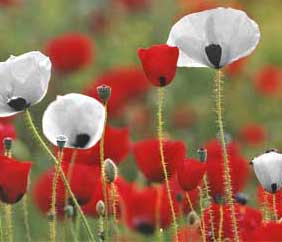by Kelly Reichel

(Image source: Peace Pledge union)
Every year around the beginning of November they come out again to be worn proudly; the red poppies that remind us of those who lost their lives fighting in the First World War and in conflicts since. Sometimes, however, there are also a few white poppies to be spotted. However, since they are still quite controversial and not many dare to wear the white poppy publicly, we thought we would try to explain a little about this symbol of peace.
Controversy
In 2015, the controversy was highlighted when the Labour party leader Jeremy Corbyn wore a white poppy in
November of that year - and was criticised heavily. Labour MP Simon Danczuk commented on Corbyn’s white poppy:
It is deeply offensive to our armed forces, who have given their lives for the democracy and freedoms he enjoys.
But what does the white poppy stand for?
Just like the traditional red poppy, the white poppy is worn to commemorate those who died in war. The main difference is that while the red poppy mainly commemorates the soldiers who lost their lives while the white poppy remembers all the victims of war and wishes for an end to all wars. It aims to emphasise peace as the only desirable outcome. The Peace Pledge Union, who sell the white poppies, explain:
The White Poppy symbolises the belief that there are better ways to resolve conflicts and embodies values that reject killing fellow human beings for whatever reason.
Some supporters of the white poppy also say that the red poppy has become too political for them, as a way to glorify and justify wars.
So what’s wrong with that?
Opponents of the white poppy claim that those who wear it are insulting the soldiers that gave their lives in First World War and in conflicts since. They also criticise it for undermining the significance of the red poppy. This aspect of the controversy reaches back to the introduction of the white poppy in 1933 by the Women’s Co-operative Guild as a symbol for peace. During that time, some women even lost their jobs for wearing the white poppy. Margaret Thatcher also criticised the white poppy in the 1980s, by expressing a “deep distance” to the symbol, while others still see it quite differently.
Lindsey German from Stop the War Coalition finds that the white poppy is very appropriate as a symbol for commemorating the loss of lives in war because it represents “the best way to protect interests of soldiers” aiming to “stop sending them into these disastrous conflicts in the first place”. And even the Royal British Legion, who traditionally sell the red poppy, see no problem in wearing a white poppy:
We have no objection to white poppies, or any group expressing their views. We see no conflict in wearing the red poppy alongside the white poppy. RBL
The white poppy as a symbol of peace carries a huge importance, especially if we consider the UK’s recent involvement in wars (6 alone in the last 15 years). Despite the fact that these wars differ from the First or the Second World War, in that we here in the UK, often don’t directly see the losses and the grief they cause, they are still devastating events for a huge number of people. The results of war are not only taking place around the 11th of November but at any time of the year. So here at BPEC we feel that the white poppy should be worn to show solidarity with those that live in conflict zones all year round. Especially given that the UK has recently approved to be part of a military intervention in Syria, wearing the white poppy is an act of solidarity which shows that we won’t close our eyes from the suffering that war causes.
Kelly Reichel
You can buy your own Peace Poppy all year round at the Brighton Peace and Environment centre opposite Brighton Station, with each initial 75p going towards the PPU and anything extra helping to fund our core work in Brighton and Hove. If you would like to order them in bulk please let us know by emailing us at This email address is being protected from spambots. You need JavaScript enabled to view it.
